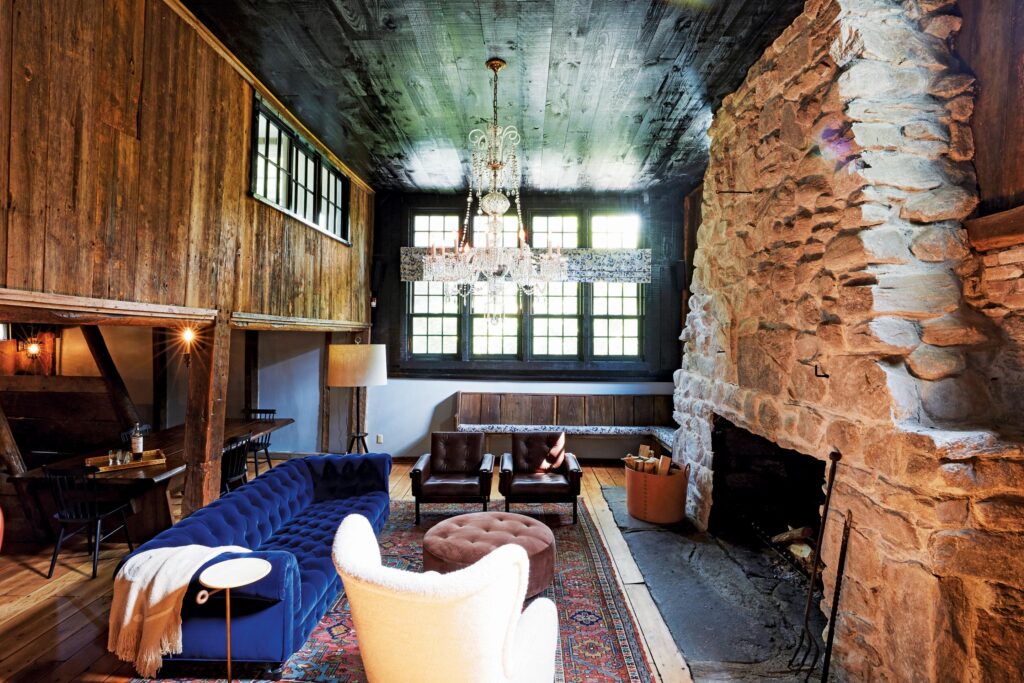On a Property in Weston, Connecticut, Designer Jennifer Bunsa Bridges the Stylistic Differences of an 18th Century Structure Where the Past Is Prologue, but the Design Is Now
Recent times, however, have seen the structure truly come into its own, made possible by a painstaking interior overhaul by designer Jennifer Bunsa of Miami-based Bunsa Studio, which worked to recreate and reconnect the original assemblage of homes on the property.
That the past is prologue in this house—but only in shades, so as not to feel of another time but decisively of this moment—is due to the designer’s thoughtful decorative choices and implementations, and the freshness and fullness of her perspective.
“My ethos as a designer is to first and foremost create comfortable and liveable spaces for my clients, and to create a functional plan that is spatially effective and serves to enhance the experience of being in each space,” says Jennifer Bunsa.
“Second to that, I like to use natural materials and derive as much inspiration from the locale as possible.”
For the John Lord House this meant using “shiplap material to bring the outside in, and exposed wood posts and beams that were buried under years of additions, allowing these to add texture and warmth to the space.”
The mostly neutral color palette, meanwhile, was selected to “serve as a foreground to the beautiful views of nature outside” and to allow the “natural beauty and texture of the materials to shine.”
Jennifer Bunsa brought all this to bear for the clients of this project—a town-and-country family with a flair for entertaining and a good eye for design who fled Tribeca for a life outside the city—designing what she describes as a “warm, engaging environment with spaces of all scales.” For cozying up on movie night.
For throwing parties and hosting company. A home that, while comfortable, was “elevated with collectible design elements throughout.”
That John Lord House is highly intentional about contrast speaks to Jennifer Bunsa’s impulse to create decorative tension, here with shiplap, marble, and leather in striking coexistence with Zellige tiles, reclaimed French oak floors (a nod to the husband’s French heritage), and warm wood tones with a splash of pattern and judicious hits of black used for windows, walls, cabinets, and seating.
Jennifer Bunsa turned what might have been Old World impediments, like the low ceiling in the family room—one of the more unworkable holdovers of the 1700’s home—into a memorable focal point. Structurally, the ceiling could not be raised, so Bunsa outfitted it with barn beams for added texture that not only frame the space but announce it. She also trimmed back the built-ins in this room, ridding them of their ornateness for a more clean-lined posture and accenting them with leather cabinet pulls. (Wisely, the TV is not central.)
Given the lady of the house’s wine and food background, the kitchen is a showcase, with a textural backsplash and a conspicuous piece of lighting that presents as art and has a vaguely nautical feel.
Chosen for its handmade and tactile quality, the fixture’s “varying sizes and swagged chains lend a sculptural element that adds to the open kitchen space and helps define it as a separate zone from the dining area,” explains Jennifer Bunsa.
It also ensnares the eye with its edgy, industrial vibe and sets the tone for other contemporary lighting pieces used throughout that, together, creates a kind of modern misc-en-scene within the antique shell.
Jennifer Bunsa’s ability to strike a balance between old and new, classic and modern, has given this perennially in-progress period house a consistency for a new age.
“I love the way Europeans do additions,” she confesses.
“They don’t try to replicate what is there, but rather to make something new and current, which serves to contrast with the historical building. In terms of the interior furnishings, I love to mix old and new as well in this way. I feel that vintage pieces add so much character to the space because they have stories to tell, and they have a beautiful patina of time-worn on their surfaces. When contrasted with new designs, they begin to have a dialogue with one another and this creates a timeless space.”
John Lord House is, more broadly, a reflection of Bunsa as a designer—one inspired both by travel and all aspects of design, especially the Scandinavian and Japanese aesthetic. Here, she thought of everything.
“I love clever details and thoughtfully designed spaces and am very inspired by other designers who have an inventive spirit and strive to create something new and thoughtful in this world,” says Jennifer Bunsa, who you can count among them. One only look to Connecticut, wherein preserving the spirit of an old house, she bared its soul.
Jennifer Bunsa of Bunsa Studio | bunsa.studio
Photos: Nicole Franzen














